Tours

Rome Tourist Card
Rome Tourist Card
Snap up the Rome Tourist Card and you'll get everything you need to explore Rome's top highlights including Colosseum, Palatine Hill, Roman Forum and Hop on/off bus. You can even choose the order you see things in.

Colosseum, Roman Forum & Palatine Hill: Priority Entrance
Colosseum, Roman Forum & Palatine Hill: Priority Entrance
Skip the long lines at the Colosseum with this priority-entrance ticket. This ticket will let you bypass the crowds. And after exploring the Colosseum you can head to the area of the Roman Forum and the Palatine Hill.
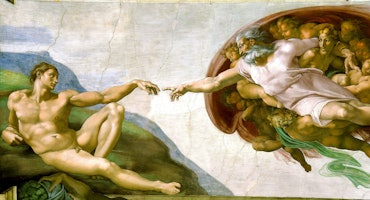
Vatican Museums & Sistine Chapel: Skip The Line
Vatican Museums & Sistine Chapel: Skip The Line
This ticket will make you save stress and time by allowing you to get priority entrance and skip the line. Visit the the countless masterpieces by Michelangelo, Raphael, Caravaggio, Tiziano and the Sistine chapel.
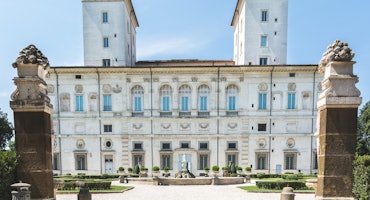
Borghese Gallery: Fast Track
Borghese Gallery: Fast Track
Galleria Borghese is located in the villa of the park Villa Borghese. Admire the architecture and furnishings of this beautiful villa. It is a museum full of art from the Renaissance. The collection includes several sculptures and paintings. Because of limited capacity get tickets for this museum weeks in advance.
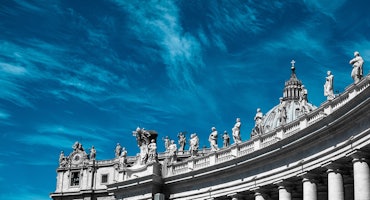
St. Peter’s Basilica: Dome Climb with Guide
St. Peter’s Basilica: Dome Climb with Guide
Get the most out of your visit to St. Peters with a guided tour to climb the basilica’s dome designed by Michelangelo and admire one of the stunning view. After the tour, you can explore the the basilica at your own pace.
The Catacombs of Rome
Today, we descend underground, wandering through intricate tunnels, passageways, burial and worship sites, up to the final destination: the origin of the Church. Contrary to popular belief, the catacombs were burial sites, well known by the authorities, and not hiding places to escape from persecution. Plus, those places were situated just outside the city, at the sides of the main roads leading to Rome. There are more than 50 catacombs, meandering underground for the impressive length of approximately 150 kilometers.
Easy to access, and regularly listed in the land registry, the hundreds of kilometers of catacombs did not offer any secure hideaway spot. But they had a fundamental function, which was giving a proper burial to all the members of the Christian community, from the noble person, to the slave. The catacombs have been enriched with frescoes and a new symbology, aiming at teaching the New Testament through images. The Christian community gathered in private homes for the Eucharistic celebration (and not underground), but this does not diminish the value of the catacombs, as one of the main evidences of the religious fervor and sense of belonging of the early Christians.
As is widely known, Christians did not have an easy life in ancient Rome. Their god was strongly opposed by the Empire. This is easily explained: the followers of this new religion did not recognize the Emperor as the highest authority on earth. The commandments were the path to follow in everything spiritual, and, actually, their entire life had to be based on the New Testament. This was, indeed, regarded as dangerous and revolutionary.
Travel Tips
Each catacomb complex has its own opening hours. Normally, they are open mornings and afternoons, with a lunch break of approximately 3 hours.
It’s better to wear comfortable shoes or sneakers. At some sites, there might be some difficulty for people with reduced mobility. Unfortunately, the catacombs are not accessible with wheelchairs or strollers.
As the tunnels are underground, there is a notable temperature difference between the catacombs and ground level. Even in the summertime, you will find that they are incredibly fresh (around 15° C) and very humid as well. Consider bringing a light jacket with you to put on during the visit.
Tickets
Do you want to visit one of the Catacombs? Then it is recommended to buy your tickets online.
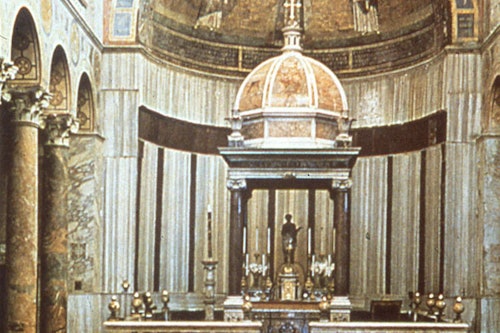
Catacombs of St. Agnes: Guided Tour
Catacombs of St. Agnes: Guided Tour
The Catacombs of S. Agnese are one of the most important burial sites of early Christians. Explore this fascinating subterranean world, its galleries and rooms. Learn about the symbols carved into the stone walls and the stories of the martyrs and the popes buried here. The ticket includes fast track entrance and a guided tour that lasts about 30 minutes. It’s the perfect tour to discover the catacombs, especially if this is your first visit to Rome.
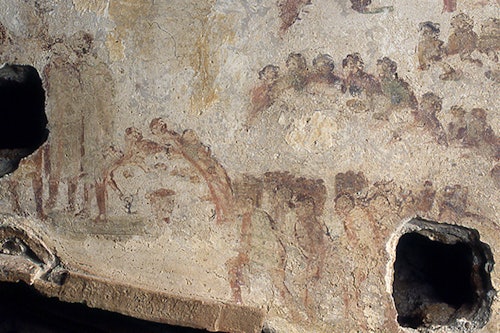
The Catacombs of San Sebastiano: Guided Tour
The Catacombs of San Sebastiano: Guided Tour
A place of worship and pilgrim destination since the Middle Ages, the Catacombs of San Sebastiano are an important historical landmark. Here you can admire mausoleums with stucco decorations and explore the galleries and rooms used for burial, but also for funeral ceremonies. With the help of a dedicated guide, you will travel back in time to the third century AD and witness the beginning of Christianity in Rome. The tour lasts about 40 minutes.
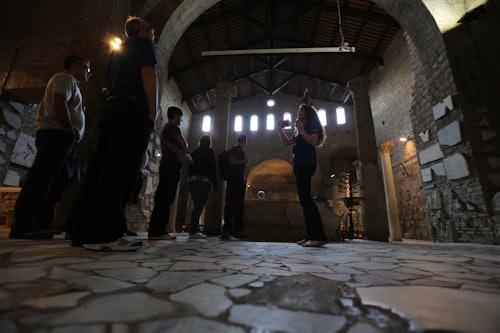
Roman Crypts and Catacombs Tour in English
Roman Crypts and Catacombs Tour in English
Explore the best kept secrets of underground Rome with this guided tour in English. You will have access to some of the most famous catacombs (Santa Domitilla and San Callisto), with their frescoes and shrines, and also to the crypt of the Capuchin monks, featuring unique chapels entirely decorated with human bones. You’ll also visit the underground site of the Basilica of San Martino ai Monti. The ticket includes transport on an air conditioned bus.

Priscilla Catacomb: Guided Tour
Priscilla Catacomb: Guided Tour
The Catacombs of Priscilla is one of the most famous underground burial site in Rome. They are located on Via Salaria, in front of the Villa Ada park. The catacombs feature many tunnels and cubicles, decorated rooms and they are the resting place of many early Christian martyrs. You will have the chance to experience this fascinating visit with the help of a guide. The tour lasts about 45 minutes. It is recommended to wear comfortable shoes and bring a jacket or jumper.
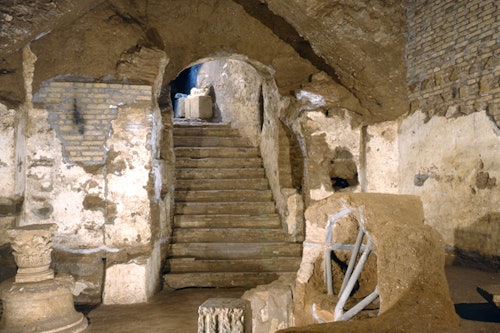
Catacombs of Saints Marcellin and Peter
Catacombs of Saints Marcellin and Peter
A guided tour to explore these three-level catacombs, which span a total area of about 18.000 square meters. The Catacombs of Marcellin and Peter were dug between the 3rd and the 5th century. Here there are the tombs of many Christian martyrs, killed during the terrible persecution of the Emperor Diocletian. You will see ancient tombstones, well preserved frescoes and inscriptions. It’s an evocative and fascinating look into a fundamental chapter of the history of Rome.
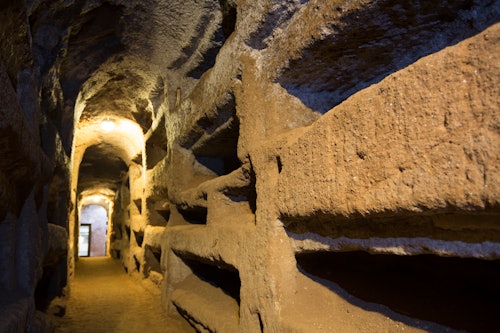
Catacombs of St. Callixtus: Guided Tour
Catacombs of St. Callixtus: Guided Tour
There is not only much to discover in Rome above ground, this certainly also applies underground. Christianity used to be a forbidden religion in Rome. Despite the ban, this belief was on the rise. The Christians buried their dead in an underground system called the Catacombs. This guided tour is through the Catacombs of St. Callixtus (where nine Popes are buried). On Wednesdays there is a guided tour of the catacombs of Santa Domitilia.

Guided Catacombs Tour + Shuttle Bus
Guided Catacombs Tour + Shuttle Bus
This tour will give you the opportunity to discover the famous underground cemeteries of Rome: the Catacombs. At the beginning of the tour, a video will explain the historical background and the use of the tunnels during the Roman empire and the Christian persecution. Then, after a short trip on a shuttle bus, a guide will take you down to one of the largest sites of this kind: the Catacombs of Saint Callixtus, located on the ancient Appian Way.
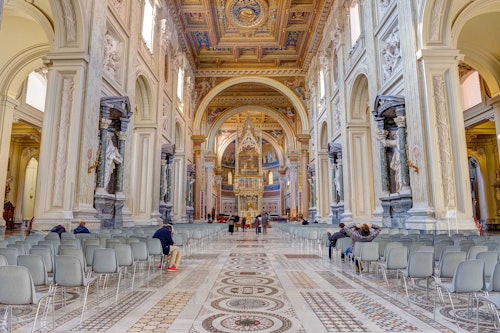
San Callisto & Basilica of San Giovanni in Laterano
San Callisto & Basilica of San Giovanni in Laterano
This combo ticket will give you entrance to two sites: the Basilica of Saint John in Lateran (and its complex) and the catacombs of Saint Callisto. You can explore the basilica, with the near Scala Santa (Holy Staicase), the famous chapel of the Sancta Santorum and the cloister, with the aid of an audio guide. When you visit the catacombs, you will join a local guide, to learn everything about the underground cemeteries of the early Christians and martyrs.
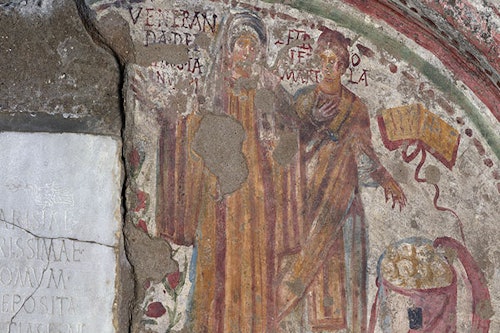
The Catacombs of Domitilla: Guided Tour
The Catacombs of Domitilla: Guided Tour
Visit one of the most famous catacombs in Rome. Discover the life of early Christians and the important role of the women in Evangelization with a tour through these galleries and tunnels, which have been a pilgrimage site since the Middle Ages. Here, you’ll find amazingly preserved frescoes, tombs and artifacts. Your guide will also take you for a tour in the semi-subterranean ancient basilica dedicated to Nereo and Achilleo. The tour lasts about 1 hour.
The Origin of the Catacombs
Rome had strict laws which prohibited burying the dead inside the city walls. The burial sites were usually carved underground, in specific sites where the tuff stone allowed a relatively easy excavation. The catacombs you will visit were, originally, destined to the urns of the pagans. Romans used to incinerate the bodies. One interesting fact has to do with the way the authorities took track of the increase and decrease of the number of residents. For each death, a dinar had to be paid to a deity (which was a tax, really). Same, for each birth, the parents had to pay a dinar (to another deity, aka another tax). This way, at the end of the year, it was easy to count of how many people were born and had died.
Christians believed in the resurrection of the bodies, so they preferred to embalm the body, wrap it with a linen cloth and then bury it. Plus, given the high sense of community they had, the cemetery became a way to keep the followers of Christ together, even after their passing away. From the II century onward, also thanks to many land donations, Christians started using and extending the preexisting pagan burial sites, which were predominantly used only for the members of one family.
That’s when the catacombs started to seriously develop. Those sites were largely used up to the V century, but still maintained until the IX century AD. During the early Middle Ages, Rome was frequently sacked by the Barbarians. To avoid the stealing of the precious relics of the saints, those were moved by the pope in the city center, and later placed in different churches.
The catacombs are decorated with frescoes, columns and small chapels. In the tunnels, you will find those three elements:
- The loculus, a simple tomb of rectangular form
- The arcosolium, a cluster of tombs surmounted by an arch painted with frescoes, used by families.
- The cubiculum, a small burial room, often a private chapel for families or for people of the same trade.
The three largest complexes of catacombs are on the Via Appia road.
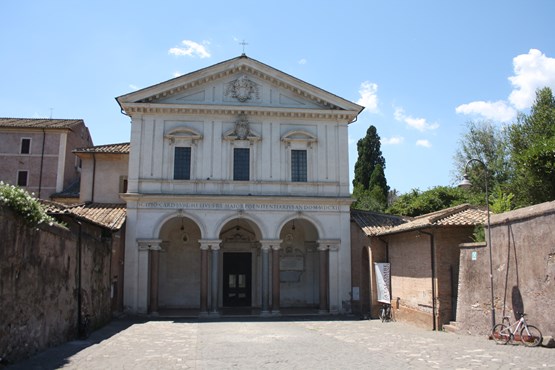
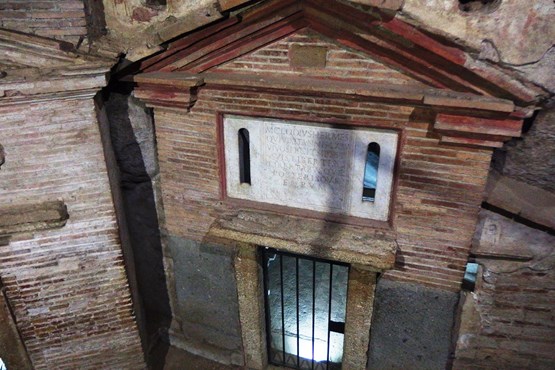
The San Callisto Catacombs
These catacombs are among the largest in Rome, featuring around 20 kilometers of underground tunnels. They are situated near the small church of the “Quo Vadis”. When fleeing Rome to avoid martyrdom, Saint Peter had a vision of Christ walking towards Rome. Peter asked “Domine, quo vadis?” (My Lord, where are you going?) Peter soon realized that Christ wanted to show him that he had to head back to Rome, and fulfill his destiny, even if that meant facing torture and death.
When, at the beginning of the III century, the pope appointed the deacon Callisto as the administrator of the cemetery, the area became the Church’s official burial site. Today, this place is a destination for pilgrims. Here, you will find the tombs of many martyrs and 16 popes. Cecilia, the patron saint of music and martyr, is buried here. Her tomb was venerated up to the IX century, when her relics were taken to the church built in her honor.
Address: Via Appia 110/126
Tour info and opening hours: Monday to Sunday, 9am-12pm; 2-5pm. Closed on Wednesdays, Christmas day, Easter, the 1st of January and from mid January to mid February (check the exact dates when booking).

The San Sebastiano Catacombs
Located in Via Appia, these catacombs are named after San Sebastiano, a legendary figure who served as the captain of the Praetorian Guard (the Emperor’s personal guards). He converted many people and helped Christians imprisoned by the Emperor Diocletian. Once the emperor discovered him, he was sentenced to be shot dead by arrows. Miraculously, he survived and went back to the emperor, to express his reprimand against his conduct toward the Christians. Diocletian ordered his death by flogging. His corpse was secretly carried to this cemetery.
The very name “catacomb” comes from this particular site, from Latin “ad catacumbas”, literally, “near the hollows”, which is referred to the tufa mines of the area. The site was used from the first century AD for pagan burials, and from the III to the V century as a Christian cemetery. The tunnels extend on three levels, for a total length of 12 kilometers. Some mausoleums were even erected above the ground. The complex was used for celebrations in honor of the Saints Peter and Paul. After his conversion, the emperor Constantine also built a large basilica here.
Address: via Appia Antica, 136.
Tour info and opening hours: Mon to Sat 10am to 4:30pm. Sundays and 1st of January closed. Also closed for the whole month of December.
The Praetextatus Catacombs
The Praetextatus catacombs were founded by an aristocratic Roman family, who owned the land at the side of the Appia Antica road. From the second century AD onward they had already been used to bury members of the senate and of the Imperial family. Later on, it became a Christian cemetery. Above the ground, there were monuments, shrines and also two churches. It has been a well known pilgramage site for some centuries. The catacombs include the tombs of several saints and martyrs. The tunnels feature some monumental traits, including a wide hall with marble columns called the spelunca magna and the cubicle of the coronatio, with many fine frescoes.
Abandoned and neglected, the complex was then brought to light by Enrico de Rossi in the middle of the XIX century. De Rossi was an archaeologist who devoted his life to the study of the catacombs. At the time of its discovery, the main access stairs to the underground levels were still functional.
Address: Via Appia Pignatelli, 11.
Tour info and opening hours: Visits by appointment only
The Domitilla Catacombs
Situated on the Via Ardeatina, in the Southern area of the city, these catacombs are 17 kilometers long, on four different levels. The complex also includes a church. It’s the burial site of approximately 150,000 Christians. They are named after Saint Domitilla, who belonged to the noble family called Gens Flavia. They were persecuted by the emperor Domitian.
At one point, many members of the family were condemned to exile, and they donated their land to the Church. Among the most notable tombs, are those of the Martyrs Nereo and Achilleo. The Domitilla catacombs feature an underground basilica (a church) built in the IV century AD.
Address: Via delle Sette Chiese, 282
Tour info and opening hours: Monday to Sunday, 9am-12pm; 2pm-5pm. Closed on Tuesdays.

Early Christianity: Noble Women and Martyrs
Originally, the new religion was embraced by free people of the lower and middle class. The upper class was excluded at first, mainly because high offices included some duties related to the celebration of some pagan religion duties, such as public sacrifices, which were incompatible with Christianity.
If men of high status were somehow precluded to follow the teaching of Christ, it was not the same for women. In fact, many noble women converted to Christianity, which led to a strong sense universal brotherhood with the other members of the cult, and at the same time conveyed a message of gender equity, somehow missing in the ancient Roman society.
In the beginning, Christians were mistaken as Jews and they were tolerated just as the other minorities. The first clash with the authorities was caused by Nero, when he accused the Christian community to be responsible for the fire that raged Rome in 64 AD. The fire was probably malicious, it was neither caused by the Christians nor by Nero. Its origin is still uncertain.
Persecutions and martyrdom of the Christians began under Nero and went on until the year 300 AD. It all ended with the conversion of the Emperor Constantine, in the year 313 AD, when he proclaimed the freedom of worship. In 380 AD, the Emperor Teodosio decided to elect Christianity as the official state religion. He closed the pagan temples and banned sacrifices to the gods, on pain of death.
From Darkness to Light: the Unearthing of the Catacombs
The Barbarians (mainly the Goths and the Longobards) stormed Italy several times during the early Middle Ages. Rome was one of the main destinations for raids and pillaging. For security reasons, as we have already mentioned, the popes moved all the sacred relics in the city’s churches.
After some time, the catacombs were completely neglected and abandoned, except three (including the San Sebastiano one). Small landslides and growing vegetation completely hid the access to the burial sites. People lost any trace of them and, up to the end of the Midle Ages and beyond, nobody knew the exact location of the catacombs.
The archaeological exploration began in 1500 with Antonio Bosio, who was called “the Columbus of subterranean Rome”. But a systematic study of the sites took place only in the XIX century, with Giovanni Battista de Rossi, who is considered the founder of Christian archaeology.
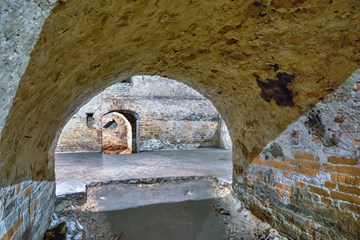

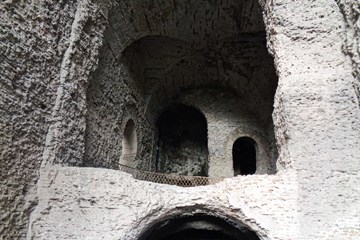
Art in the Catacombs: Between a New Symbology and the Mystery Cults
Early Christian art has strong links with Roman art; paintings, sculptures and frescoes were, after all, made by artists and craftsmen belonging to the same society that was mainly pagan. In a stylistic point of view, there are not many differences, but it all changes when it comes to the subjects depicted.
In the catacombs, art becomes a way to teach the New Testament through recurring images and symbols. Actually, the high symbology used in the catacombs has also later been used in churches. Many of the images depict scenes of salvation and miracles.
Jesus was often depicted as a fish. This was part of the secret code of early Christians. The Greek word for “fish” is ICTUS (ΙΧΘΥΣ ), which was an acronym for “Jesus Christ, Son of God, the Saviour”.
The dove illustrates peace in heaven. The anchor is the symbol of the strength rooted in faith and the peacock, who changes its feathers every year, represents rebirth. The phoenix, the Arabic bird believed to come back to life from its ashes centuries after its death, symbolizes the resurrection.
The palm tree is both connected with martyrdom and resurrection. In fact, the plant blooms when it looks as if it’s already dead, in the same way in which a Christian faces martyrdom and then receives compensation in heaven.
Some of the images are adaptations of pagan depictions. For example, the Good Shepherd (either with a lamb on his shoulders, or with two lambs at his side) comes from a reinterpretation of the god Hermes the Messenger or Mithra, who were both often depicted with a sheep or lamb.
The pagan religion in ancient Rome was directly derived from Greek mythology. In the first/second century BC, the Empire had stretched up to the limits of the known world, and other cults arrived in the city, often introduced by legionaries coming from far provinces. Mostly, those cults were an esoteric derivation of the Greek religion, but also rituals based on other deities, such as Mithra, a Persian god. To be able to access those “mystery cults”, the adept has to undergo a purification ritual (some sort of baptism). After that, he was admitted to take part in the rituals. The cult of Mithra was often juxtaposed to Christianity. Mithra was also called the “total deity” and his mythology saw Mithra as part of a trinity, together with the Sun and Saturn. Plus, it was worshipped on the 25th of December!
Shortly after Christianity became the official (and only) religion, the Mithra followers were persecuted or converted to the new religion, which had many traits in common with the ancient cult. Some of the sites used to worship Mithra were buried and used as foundations for the new Christian churches. San Clemente, for example, features, two levels below the ground, one of the best preserved Mithraic worship sites of the Italic Peninsula.
FAQ
What are the Catacombs in Rome?
The Catacombs are underground cemeteries.
Where are the Catacombs in Rome?
Rome has several Catacombs. These Catacombs can be found all over Rome. Sebastian's catacombs are located on the Via Appia just outside the city wall. The catacombs of Priscilla are on the via Salaria
Which Catacombs in Rome is the best?
The Catacombs of Domitilla are highly recommended. These are the oldest and largest Catacombs in Rome.
How many Catacombs are there in Rome?
There are fifteen Catacombs in Rome



